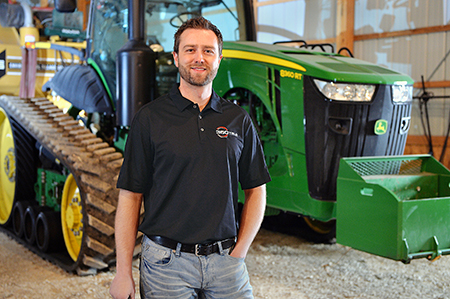This yearlong endeavor looks at how four farmers are evaluating technology and agronomic information that can boost the productivity of their operations.

Information is power, and Ben Pederson thrives on it. For the north-central Iowa farmer, testing new agronomic concepts and capturing enough data are the steps necessary to document the need for change.
"Nothing is so sacred that we can't reexamine to be sure it actually is the best way to do things," says Pederson, who farms with his father, Gary, near Lake Mills. "For 2015, I sampled several farms intensively, with micronutrient levels included in the results. It was these soil tests that drove us to reformulate our in-furrow [practices] with a higher rate of zinc and the addition of manganese. We are trying to steer away from the 'shotgun' approach and move toward one that is directed by testing and results."
Data gathered in 2014 and tight margins heading into 2015 led Pederson to retest the need for fall-applied phosphorus (P) and potassium (K). This past fall, Pederson shut off dry fertilizer on several 120-foot-wide strips in an effort to get a better idea of the profitability threshold of dry fertilizer applications. He expects to see a yield decline, but he wants to know the exact economic penalty for not applying dry P and K fertilizer in one growing season.
"We are getting our soil health moving in the right direction with some fields that have been strip-tilled for going on four years," Pederson says. "It is time to see if reducing P and K inputs even further is the economically optimum choice. It could be possible that our in-furrow is enough on those fields with higher levels of fertility."
The proof will be in 2015 harvest data.
Farmwide change doesn't occur overnight. For example, after three seasons, nearly half the farm's acres are now strip-tilled with the remainder in a more conventional, conservation-till program. Pederson gives his father a lot of credit for being willing to change a lifelong tillage practice.
"Yield will always be king for him, and he's not far of there," he says of his father. "In his book, it takes a few years to prove this is the right path."
Strip-till has proven to be the ideal hybrid of conventional tillage and no-till when faced with cold, wet spring soils covered in heavy residue. Pederson uses a Soil Warrior to make a 10- to 12-inch-deep coulter-tillage pass in the fall and follows with a shallow spring pass to prepare for planting.
"Strip-tilling leaves more soil undisturbed to allow soil biology to thrive, yet it exposes a strip of black soil for a warm seedbed," Pederson says. "I love coulter tillage mostly for the fact it is completely vertical. No smear layers or abrupt density changes are created. I can easily dig up to my elbow with my bare hands in the strips behind the strip tiller."
With yields comparable to conventional, he gives striptill extra credit for operational efficiency and conservation.
“"y intention is to make it our practice on every acre in the future based on the encouraging things we have seen from our crops and our soils."
Pederson took an aggressive approach to crop health in 2014 with a two-step program of Priaxor fungicide on corn at the V5 to V8 stage and a tassel application of Headline AMP fungicide in corn. He applied Priaxor at R3 in soybeans.
"He tested the program in previous years and saw nice results in 2014," says BASF innovation specialist Kyle Shirk. "This spring, he'll be evaluating Xanthion In-furrow fungicide."
When heavy rains prevented planting in 2013, Pederson seeded a diverse mix of cover crops that included lentils, radish, annual rye, sunn hemp and vetch. He strip-tilled directly into the cover crops that fall, and those fields yielded better than those without cover crops in 2014.
"The soils in those fields were teaming with life in 2014 with more tilth and better structure," he says. "Our challenge now is to incorporate cover crops into our normal cash-crop system."
Nitrogen efficiency is on his radar, too. This spring, he's taking a look at Limus nitrogen management, the new N stabilizer from BASF. Pederson suspects the wet spring in 2014 depleted initial N reserves. Sidedressing after July 4 with a high-clearance sprayer and drops produced good yields. However, Pederson still saw some hybrids turn that lighter shade of green that signals N deficiencies.
"I think yields could have been even better if the second dose of N had been earlier," Pederson says. "This year, we will move sidedressing to V8 to V10 stages, especially if we have another wet spring."
Improving fertilizer efficiency is an area where Pederson believes he can do better. "What excites me is getting the soil to release a greater portion of what is already present in the first place through biological activity," he says. "For example, I think we will soon be able to more reliably predict how much nitrogen we really need to add to complement what soil organic matter provides and avoid overapplication."
This would be important economically, but also environmentally, Pederson notes. "We need to steer our farms away from using excess nutrients if we are to avoid increased government regulation," he says. "Also, it is just the right thing to do as stewards of the land."